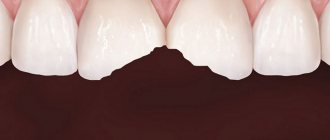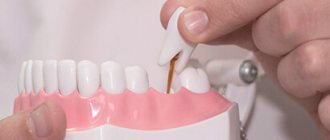Treatment of dental pathologies in children is a complex process that requires extensive practical experience and knowledge of child psychology. Especially when it comes to baby teeth. In order not to damage the rudiments of permanent units, the doctor must perfectly know the technique of performing manipulations and act very carefully.
Children's doctors at the Levoberezhnaya Dental Clinic try to save teeth even with extensive damage and remove them only as a last resort. You can make an appointment by calling the phone number listed on the website or using the online form.
Features of treatment of children's teeth
Dental treatment in childhood requires compliance with a number of features. The methods are similar to those used for adults, but there are some differences. In general, pediatric dentistry is a separate “world” in which only experienced doctors who know how to approach children work. This requires a lot of experience and communication skills with young patients, since in some cases you have to try hard to calm the child down and carry out treatment in a favorable environment for him.
How to treat teeth at 1 year old
The first visit to the dentist is recommended at the age of one year. During the initial appointment, the specialist carefully examines not only the milk teeth, but also the frenulum of the lips and tongue. A visit to the doctor at this age is extremely necessary to promptly detect and then eliminate:
- bite defects;
- frenulum abnormalities;
- gum pathologies and other possible disorders.
If any diseases are discovered during the examination, the specialist prescribes treatment. If there is an assumption that manipulations may cause pain or discomfort to the child, anesthesia is used.
How to treat teeth at 2–3 years old
At the age of two to three years, for preventive purposes, the child should be taken to an appointment not only with a dentist, but also with a hygienist, since during this period most children usually erupt all their milk teeth, and they require special care. At the initial appointment, the doctor examines the oral cavity and assesses the correctness of the bite. In addition, all baby teeth are checked for cavities.
Most often, at 2–3 years of age, caries is diagnosed at the “spot” stage, when deep tissue structures have not yet been affected. In this case, two treatment methods are usually used:
- Remineralization.
The procedure is painless and performed without anesthesia. The method is based on the use of special compounds based on fluorine, calcium and phosphorus. The product is applied directly to the affected area and allows you to restore the mineral balance of the tooth.
- Silvering.
During the procedure, the teeth are coated with a special silver-based compound, which protects the enamel for a long time and prevents the re-development of caries.
Most often, using such methods, the stain is removed without instrumental intervention. If caries has affected deeper layers, it is impossible to do without removing the affected tissue, cleaning and filling.
How to treat teeth at 4–5 years old
If during diagnosis the doctor discovers caries, the most common disease at this age, treatment is prescribed according to the following algorithm:
- treatment of the oral cavity with antiseptic drugs;
- applying “freezing” agents to the gums in the area where the anesthetic was administered;
- injection administration of anesthesia;
- removal of affected tissue using special tools or a drill;
- filling.
The whole process takes about 30–40 minutes, sometimes more depending on the size and severity of the caries, and the child does not feel anything, since the procedure is carried out only after the anesthesia has taken effect.
If gum disease is diagnosed, topical agents are most often prescribed - ointments, creams, gels, as well as rinsing the mouth with pharmaceutical solutions or tinctures of medicinal herbs. In severe forms of pathologies, medications can be prescribed that eliminate inflammation and relieve painful symptoms.
How to treat teeth for children over 5 years old
At the age of 5 to 7 years, the replacement of baby teeth with permanent ones begins. During this period, particularly careful hygiene and regular visits to the dentist are required, as it is necessary to monitor the condition of the enamel, which is formed gradually over 2–4 years.
After 7 years, bite problems often arise. This is due to the fact that instead of a gradual increase in the jaw in proportion to the growth of permanent teeth, some kind of failure occurs, as a result of which anomalies appear - incomplete closure, displacement of the dentition, malocclusion, etc. In such cases, the therapeutic course includes not only wearing braces and other orthopedic structures, but also visiting a speech therapist.
Types and features of dental hypoplasia
Based on clinical manifestations, several forms of pathology are distinguished:
- Erosive . Oval or round defects appear on the surface of the teeth. Damage comes in different sizes. They are often covered with a thin layer of enamel, and dentin can be seen inside the recesses.
- Wavy . The appearance of multiple horizontal lines on the outer surface of the teeth.
- Spotted . The structure of the enamel itself does not change, but white or yellowish spots appear on it.
- Sulcata . Grooves of varying depths parallel to the cutting edge of the tooth.
- Aplastic . Almost complete absence of tooth enamel - only small areas of the teeth are covered with it.
- Mixed . A combination of several forms, for example, erosive and wavy.
Depending on the severity, the disease can be systemic or local. In the first case, erosive pathology affects many teeth in the upper and lower jaw. In the second, the lesions are point-like and appear on one or two teeth.
Systemic hypoplasia
Pathological changes of a systemic nature are reflected in the shape of the dental units. They are classified into several types:
- Hutchinson's teeth . The anomaly affects the central upper incisors - with pathology, they have a barrel shape. There is a semicircular notch on the cutting edge.
- Pflueger's teeth . As a rule, permanent molars are subject to changes. They are barrel-shaped and have a poorly developed chewing surface. The shape of Pflueger's molars is very similar to cones.
- Fournier's teeth . The dental units look like Hutchinson's sign, but there are no characteristic grooves below.
Local hypoplasia
Local hypoplasia of tooth enamel occurs due to problems with baby teeth, inflammatory processes during the formation of the rudiments of permanent teeth, mechanical injuries to the jaw, and infections. Pathology often manifests itself in the form of shallow stripes or spots.
Treatment of baby teeth
To prevent the child from getting scared and feeling pain, anesthesia is carried out in two stages. To begin with, a “freezing” spray or gel is applied to the gums, and then an anesthetic drug is injected with a syringe with a very thin needle. After the anesthesia begins to take effect, the affected tissue is carefully removed using a special instrument, and then the cavity is filled with materials containing fluoride and other mineral components that strengthen the teeth. The treatment is carried out in sessions, each of which lasts no more than 30 minutes, so that the child does not get tired and start being capricious.
Treatment of permanent teeth
Treatment of caries of permanent teeth in children is carried out according to the same principle as in adults, only with the use of special photocomposites.
Stages of treatment:
- Introduction of anesthesia.
- Removal of affected tissue. Typically, pathogenic foci are eliminated using a drill, after which the cavity is thoroughly cleaned.
- Treatment of teeth with antiseptic preparations.
- Drying with air jet.
- Application of phosphate cement insulating material.
- Filling.
The initial stage of caries is treated with remineralization or, for example, ozone therapy. The silvering method is not used for permanent teeth.
Do baby teeth need to be treated?
Many people believe that if a tooth falls out anyway, then it does not need treatment. In fact, this is far from the case. Baby teeth perform very important functions. They ensure proper growth of the jaw, protect the rudiment of the permanent unit from infection by pathogenic microbes and prevent the development of malocclusion. If a baby tooth is not treated, caries penetrates deep into the tissue, which inevitably causes damage to the rudiment. In the future, this leads to various pathologies, including dental anomalies, speech disorders and much more. To avoid this, it is very important to carry out timely treatment of baby teeth at the first stage of disease development, and not to remove them.
Causes
Dental hypoplasia occurs due to metabolic disorders in the fetal body at the stage of intrauterine development, as well as when exposed to negative external factors. In children, hypoplasia is often caused by:
- Rh conflict between mother and child;
- infectious diseases, acute respiratory viral infections, suffered by the mother during pregnancy;
- toxicosis, gestosis, birth trauma, premature birth;
- unbalanced nutrition of the mother, taking medications while carrying a child.
Anomalies in the development of the enamel of children's teeth often occur against the background of rickets, encephalopathy, and atopic dermatitis. Hypoplasia also affects permanent teeth: disturbances appear during the formation of the rudiments of permanent dental units.
Causes of dental pathologies in adolescents and adults:
- injuries of the maxillofacial area;
- endocrine diseases, anemia;
- pathologies of the digestive, urinary or nervous system.
Also, the condition of teeth is affected by a lack of vitamins and microelements, the use of tetracycline drugs, excess fluoride in drinking water and other factors.
Ask a Question
Dental treatment for children under anesthesia
In most cases, treatment is carried out after the introduction of anesthesia, which is divided into two types - application with local application of medication and injection, which involves the administration of an injection. The second option is safer and more effective.
If a child has panic fear or is simply restless, anesthesia is used, but before using it, a number of diagnostic measures are prescribed:
- biochemical blood test;
- general blood and urine tests;
- blood to determine sugar levels;
- electrocardiography to assess the state of the heart.
You should not eat food 5–6 hours before anesthesia, and drink water and other liquids 4 hours before.
Sleep is induced very gradually using sevoflurane-based gas. If the child needs to be woken up, the doctor increases the amount of oxygen supplied, and this can be done at any time. After waking up, all reflex functions are fully restored within the first 15 minutes. As a rule, there are no complications.
What to do if a child does not allow or is afraid to have his teeth treated?
Many children experience panic, so it is very important to intelligently approach the question of how to properly persuade a small child to have their teeth treated. To make the process painless and, perhaps, even positive, adhere to the following rules:
- Meet the doctor.
This should be done not at the moment when the tooth is already sick, but in advance - during a preventive examination.
- Motivation.
The child does not know why this is needed and what awaits him in general, so you should tell him about the importance of the procedure or, for example, show him in a playful way on his favorite toy.
- Elimination of physical force.
If a child resists, is capricious and protests, he should not be forced into the dental chair. This will not only traumatize the psyche, but will also completely discourage you from visiting dentists. Here it is better to act carefully - persuade, talk about the great benefits of treatment, or offer a new toy as a present.
- Timing.
If treatment is required, you should see a doctor without delay, but you should also consider the child’s needs. If he is used to, for example, sleeping at a certain time, you should not go to the doctor at that very moment. This is fraught with bad mood and whims. First, let your child sleep, and only after that get ready for the dentist. The same goes for eating, playing and other hobbies.
- Do not lie.
Many parents say that the doctor will only look and do nothing. This is a very big mistake, because the child expects one thing, but in the end it turns out something completely different. It will be better if you tell him the truth in a positive way.
Another good way to motivate your child is by example. If you regularly visit a doctor for preventive purposes and talk about the benefits of procedures, then your child will follow your example.
What to do if your teeth start to crumble?
With this pathology, recommendations depend solely on the factors that provoke tooth fragility. If the patient eats a lot of sweets, then this must be stopped urgently; however, for any reason, one must not forget about careful oral hygiene and a balanced diet. Particular attention should be paid to the condition of teeth during pregnancy. The intrauterine development and growth of the child takes the necessary substances and microelements from the body of the expectant mother. And very often, for this reason, a woman begins to feel a lack of calcium, which is precisely expressed in the fact that her teeth begin to crumble. Therefore, in such a situation, it is necessary to introduce as many foods containing calcium (dairy products) into the diet as possible and be sure to visit the dentist twice during pregnancy. Then the doctor will be able to notice early caries, recommend special and preventive dental care, and prevent their destruction.
Most of the recommendations for preventing tooth fragility are useful if the teeth have already begun to crumble and this process needs to be stopped urgently:
- Examination and comprehensive hygiene at the dentist: cleaning and strengthening of teeth with calcium and fluoride (recommended twice a year).
- A healthy, balanced diet rich in minerals and vitamins.
- Quitting bad habits: smoking, heavy consumption of drinks containing acids, tendency to bite nails.
- Drink water with an optimal content of salts and minerals.
And, of course, careful oral hygiene, brushing your teeth twice a day, rinsing after every meal to wash away excess sweet/sour foods, etc.











